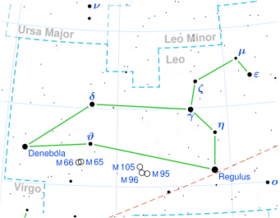Astronomy:Zeta Leonis
| Observation data Equinox J2000.0]] (ICRS) | |
|---|---|
| Constellation | Leo |
| Right ascension | 10h 16m 41.41597s[1] |
| Declination | +23° 25′ 02.3221″[1] |
| Apparent magnitude (V) | 3.33[2] |
| Characteristics | |
| Spectral type | F0 III[3][4] |
| U−B color index | +0.07[2] |
| B−V color index | +0.30[2] |
| Variable type | Suspected |
| Astrometry | |
| Radial velocity (Rv) | −15.6[5] km/s |
| Proper motion (μ) | RA: +18.39[1] mas/yr Dec.: −6.84[1] mas/yr |
| Parallax (π) | 11.90 ± 0.18[1] mas |
| Distance | 274 ± 4 ly (84 ± 1 pc) |
| Absolute magnitude (MV) | −1.19[6] |
| Details | |
| Mass | 3[7] M☉ |
| Radius | 6[8] R☉ |
| Luminosity | 85[8] L☉ |
| Surface gravity (log g) | 3.0[8] cgs |
| Temperature | 6,792[8] K |
| Metallicity [Fe/H] | −0.03[9] dex |
| Rotational velocity (v sin i) | 72.4[8] km/s |
| Other designations | |
| Database references | |
| SIMBAD | data |
Zeta Leonis (ζ Leonis, abbreviated Zeta Leo, ζ Leo), also named Adhafera /ædəˈfɪərə/,[11] is a third-magnitude star in the constellation of Leo, the lion. It forms the second star (after Gamma Leonis) in the blade of the sickle, which is an asterism formed from the head of Leo.[12]
Nomenclature
ζ Leonis (Latinised to Zeta Leonis) is the star's Bayer designation. It has the traditional name Adhafera (Aldhafera, Adhafara), which comes from the Arabic الضفيرة aḍ-ḍafīrah 'the braid/curl', a reference to its position in the lion's mane.[citation needed] In 2016, the International Astronomical Union organized a Working Group on Star Names (WGSN)[13] to catalog and standardize proper names for stars. The WGSN's first bulletin of July 2016[14] included a table of the first two batches of names approved by the WGSN; which included Adhafera for this star.
Properties
Adhafera is a giant star with a stellar classification of F0 III. Since 1943, the spectrum of this star has served as one of the stable anchor points by which other stars are classified.[4] Its apparent magnitude is +3.44, making it relatively faint for a star that is visible to the naked eye. Nevertheless, it shines with 85 times the luminosity of the Sun.[8] Adhafera has about three times the Sun's mass[7] and six times the radius of the Sun.[8] Parallax measurements from the Hipparcos satellite yield an estimated distance to Adhafera of 274 light-years (84 parsecs)[1] from the Sun.
Adhafera forms a double star with an optical companion that has an apparent magnitude of 5.90. Known as 35 Leonis, this star is separated from Adhafera by 325.9 arcseconds along a position angle of 340°.[15][16] The two stars do not form a binary star system as 35 Leo is only 100 light years from Earth, thus separating the two stars by approximately 174 light-years (53 parsecs).
References
- ↑ 1.0 1.1 1.2 1.3 1.4 1.5 van Leeuwen, F. (November 2007), "Validation of the new Hipparcos reduction", Astronomy and Astrophysics 474 (2): 653–664, doi:10.1051/0004-6361:20078357, Bibcode: 2007A&A...474..653V
- ↑ 2.0 2.1 2.2 Fernie, J. D. (May 1983), "New UBVRI photometry for 900 supergiants", Astrophysical Journal Supplement Series 52: 7–22, doi:10.1086/190856, Bibcode: 1983ApJS...52....7F
- ↑ Montes, D. et al. (November 2001), "Late-type members of young stellar kinematic groups - I. Single stars", Monthly Notices of the Royal Astronomical Society 328 (1): 45–63, doi:10.1046/j.1365-8711.2001.04781.x, Bibcode: 2001MNRAS.328...45M, http://eprints.ucm.es/30941/1/castrorubio18libre.pdf, retrieved 2018-10-24
- ↑ 4.0 4.1 Garrison, R. F. (December 1993), "Anchor Points for the MK System of Spectral Classification", Bulletin of the American Astronomical Society 25: 1319, Bibcode: 1993AAS...183.1710G, http://www.astro.utoronto.ca/~garrison/mkstds.html, retrieved 2012-02-04
- ↑ Wielen, R. et al. (1999), "Sixth Catalogue of Fundamental Stars (FK6). Part I. Basic fundamental stars with direct solutions", Veroeffentlichungen des Astronomischen Rechen-Instituts Heidelberg (Astronomisches Rechen-Institut Heidelberg) 35 (35): 1, Bibcode: 1999VeARI..35....1W
- ↑ Anderson, E.; Francis, Ch. (2012), "XHIP: An extended hipparcos compilation", Astronomy Letters 38 (5): 331, doi:10.1134/S1063773712050015, Bibcode: 2012AstL...38..331A.
- ↑ 7.0 7.1 Kaler, James B., "ADHAFERA (Zeta Leonis)", Stars (University of Illinois), http://stars.astro.illinois.edu/Sow/adhafera.html, retrieved 2010-05-12
- ↑ 8.0 8.1 8.2 8.3 8.4 8.5 8.6 Massarotti, Alessandro et al. (January 2008), "Rotational and Radial Velocities for a Sample of 761 HIPPARCOS Giants and the Role of Binarity", The Astronomical Journal 135 (1): 209–231, doi:10.1088/0004-6256/135/1/209, Bibcode: 2008AJ....135..209M
- ↑ Gray, R. O.; Graham, P. W.; Hoyt, S. R. (April 2001), "The Physical Basis of Luminosity Classification in the Late A-, F-, and Early G-Type Stars. II. Basic Parameters of Program Stars and the Role of Microturbulence", The Astronomical Journal 121 (4): 2159–2172, doi:10.1086/319957, Bibcode: 2001AJ....121.2159G
- ↑ "zet Leo -- Variable Star", SIMBAD (Centre de Données astronomiques de Strasbourg), http://simbad.u-strasbg.fr/simbad/sim-id?Ident=zeta+leo, retrieved 2010-05-12
- ↑ "List of IAU-approved Star Names". https://www.iau.org/public/themes/naming_stars/#n4.
- ↑ Proctor, Mary (July 1896), "Evenings with the Stars", Popular Astronomy 4: 565, https://books.google.com/books?id=5gdLAAAAYAAJ&pg=PA565
- ↑ "IAU Working Group on Star Names (WGSN)". https://www.iau.org/science/scientific_bodies/working_groups/280/.
- ↑ "Bulletin of the IAU Working Group on Star Names, No. 1". http://www.pas.rochester.edu/~emamajek/WGSN/WGSN_bulletin1.pdf.
- ↑ "CCDM (Catalog of Components of Double & Multiple stars (Dommanget+ 2002)", VizieR (Centre de Données astronomiques de Strasbourg), http://vizier.u-strasbg.fr/viz-bin/VizieR-S?CCDM%20J10166%2b2327A, retrieved 2010-05-12
- ↑ Adhafera, Alcyone Bright Star Catalogue, http://www.alcyone.de/SIT/mainstars/SIT000549.htm#Cat6, retrieved 2010-05-12
 |


